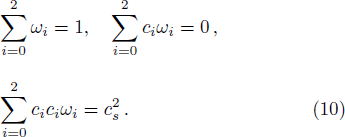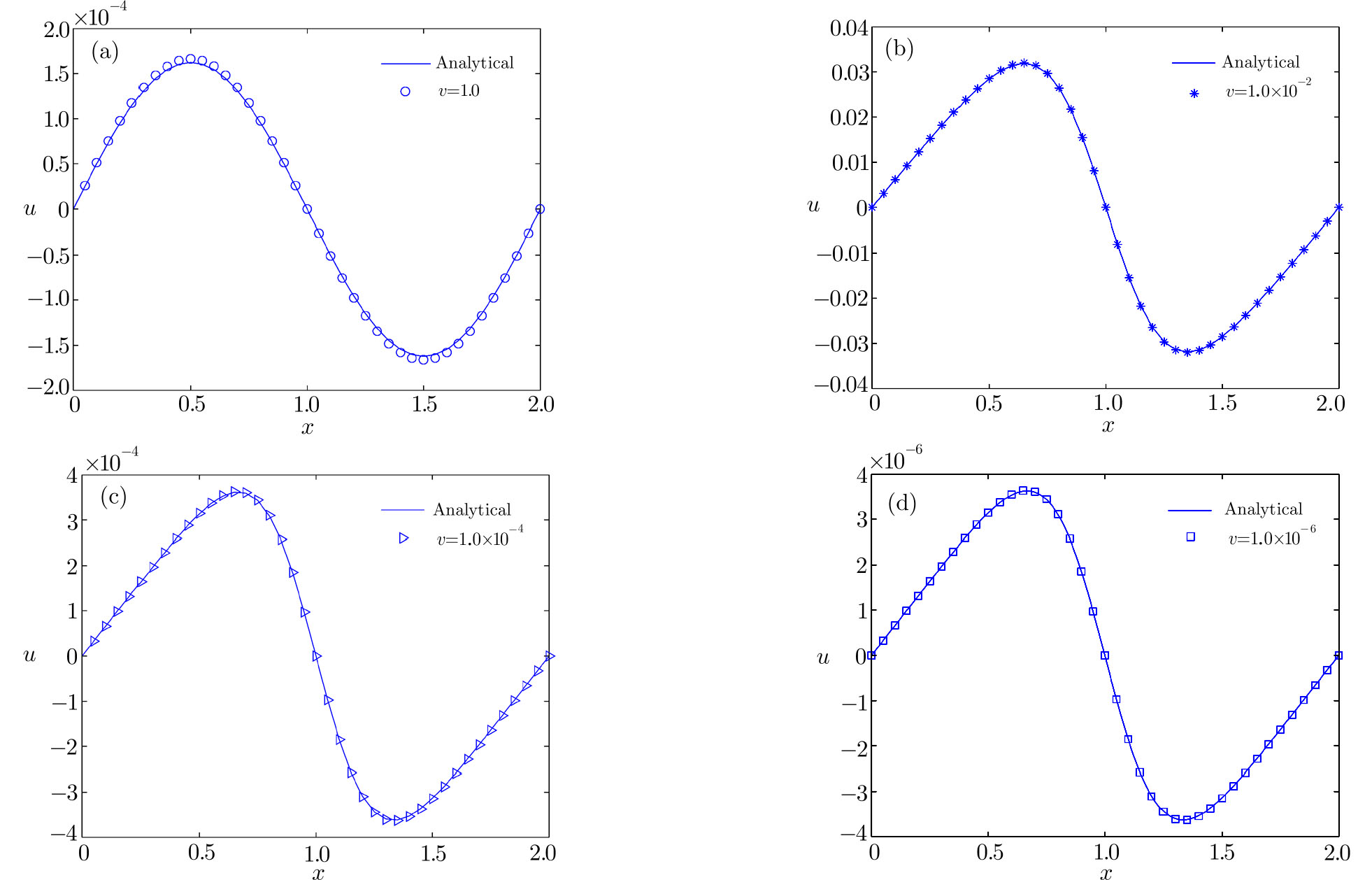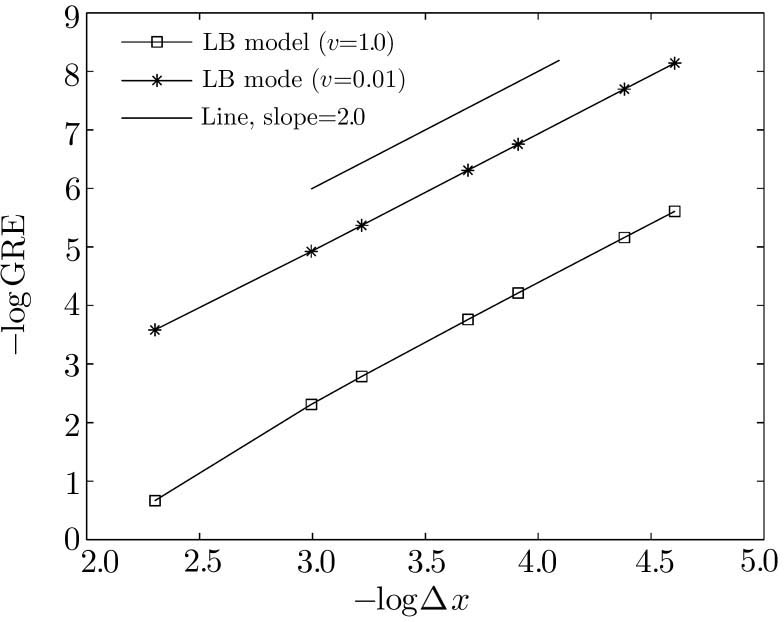† Corresponding author. E-mail:
Supported by the National Natural Science Foundation of China under Grant No. 51576079
In this paper, we present a Cole-Hopf transformation based lattice Boltzmann (LB) model for solving one-dimensional Burgers’ equation, and compared to available LB models, the effect of nonlinear convection term can be eliminated. Through Chapman-Enskog analysis, it can be found that the converted diffusion equation based on the Cole-Hopf transformation can be recovered correctly from present LB model. Some numerical tests are also performed to validate the present LB model, and the numerical results show that, similar to previous LB models, the present model also has a second-order convergence rate in space, but it is more accurate than the previous ones.
Burgers’ equation is a fundamental partial differential equation, and has gained increasing attention in the study of physical phenomenons in many fields, such as fluid mechanics,[1] nonlinear acoustics,[2] traffic flow,[3] and so on. This equation is originally introduced by Bateman in 1915,[4] and later in 1947, it is also proposed by Burgers in a mathematical modeling of turbulence,[5] after whom such an equation is widely used as the Burgers’ equation.
Over past decades, many numerical methods have been proposed to solve Burgers’ equation,[6–15] including the finite-difference (FD) method,[6–10] finite-element method,[11–12] boundary elements method, and direct variational methods.[13] Actually, these available approaches can be classified into two categories. The first one is to directly solve the nonlinear Burgers’ equation[14] with the developed numerical methods. However, as pointed out in Ref. [15], in this approach, it is more difficult to balance the convection and the diffusion terms, which usually gives rise to nonlinear propagation effects and the appearance of dissipation layers. To overcome these problems, Cole[16] and Hopf[17] introduced the so-called the Cole-Hopf transformation to eliminate the nonlinear convection term in Burgers’ equation, and consequently, the Burgers’ equation can be converted to the linear diffusion equation. Then the second indirect approach, i.e., the Cole-Hopf transformation based method, is also proposed to solve the converted linear diffusion equation.[10,13,15,18–19]
The lattice Boltzmann (LB) method, as a promising technique in computational fluid dynamics, has attracted widespread concern in recent years.[20–23] Unlike traditional numerical methods, the LB method has some distinct characteristics, including intrinsical parallelism, simplicity for programming, numerical efficiency and ease in incorporating complex boundaries. Except its applications in computational fluid dynamics, the LB method has also been extended to solve some nonlinear partial differential equations,[24] such as Poisson equation,[25] wave equation,[26] diffusion equation,[27–28] and convection-diffusion equation.[29–36] Recently, some LB models have been proposed for the Burgers’ equation,[37–45] however, there are some nonlinear terms in the local equilibrium distribution function,[37–45] which are more complex and may also generate unstable solution. To overcome the problems inherited in these available LB models for Burgers’ equation, a new Cole-Hopf transformation based LB model would be developed in this work.
The rest of the paper is organized as follows. In Sec.
In this section, the Burgers’ equation is first linearized by the Cole-Hopf transformation, and then the LB model for converted linear diffusion equation is developed.
We first consider the following one-dimensional Burgers’ equation,




With the help of Cole-Hopf transformation,[16–17]


And correspondingly, the initial condition (2) and the boundary conditions (3) can be written as
Now, we present an LB model for the linear diffusion equation (

The evolution equation of present LB model reads




It should be noted that discrete velocity ci and weight coefficient ωi should satisfy some isotropic constraints,




In the implementation of present LB model, the evolution equation (
(i) Collision: 
(ii) Propagation: 
where 
We now perform a detailed Chapman-Enskog analysis to derive converted linear diffusion from present LB model. In the Chapman-Enskog analysis, the distribution function, the time and space derivatives can be expended as



Using Eqs. (

Applying Taylor expansion to Eq. (











Finally, we would like to point out that, after computing ϕ with present LB model, we also need to adopt Eq. (

To ensure that the results of ϕ, ∂xϕ and u are more accurate, we consider the following initialization of distribution function,






In summary, we developed a Cole-Hopf transformation based LB model for Burgers’ equation and the algorithm can be found in the Appendix.
In this section, we conducted several numerical tests to validate present LB model, and to evaluate the accuracy of present model, the following global relative error (GRE) is adopted,

With above initial and boundary conditions, the solution of Eq. (




In our simulations, the computational domain is fixed to be [0,2], and the half bounce-back scheme is adopted for Neumann boundary conditions.[33,47–48]
We first carried out some simulations under different diffusion coefficients, and presented the result in Fig.
 | Fig. 1 Numerical and analytical solutions at different time ((a) ν = 1.0, (b) ν = 0.01; solid lines: analytical results, symbols: numerical results). |
| Table 1
A comparison between present LB model and some existing numerical methods (ν = 1.0). . |
| Table 2
A comparison between present LB model and some existing numerical methods (ν = 0.01). . |
Similarly, with the help of Cole-Hopf transformation, we can also derive the exact solution to Eq. (



In the following simulations, σ is set to be 2, and the periodic boundary condition is adopted.We first performed some simulations, and presented the results in Fig.
| Table 3
GREs of two LB models for Example 2 (Δx = 0.01, T = 1.0). . |
In this paper, a new Cole-Hopf transformation based LB model is proposed for Burgers’ equation. Compared to some available LB models, the present LB model is more accurate since the difficulty and error caused by nonlinear convection term can be avoided. On the other hand, the present LB model is also more efficient since a linear equilibrium distribution function is adopted. In addition, the numerical results also show that the present LB model has a second-order convergence rate in space.
In the next work, we would consider the Cole-Hopf transformation based LB models for two and three-dimensional Burgers’ equations.
| [1] | |
| [2] | |
| [3] | |
| [4] | |
| [5] | |
| [6] | |
| [7] | |
| [8] | |
| [9] | |
| [10] | |
| [11] | |
| [12] | |
| [13] | |
| [14] | |
| [15] | |
| [16] | |
| [17] | |
| [18] | |
| [19] | |
| [20] | |
| [21] | |
| [22] | |
| [23] | |
| [24] | |
| [25] | |
| [26] | |
| [27] | |
| [28] | |
| [29] | |
| [30] | |
| [31] | |
| [32] | |
| [33] | |
| [34] | |
| [35] | |
| [36] | |
| [37] | |
| [38] | |
| [39] | |
| [40] | |
| [41] | |
| [42] | |
| [43] | |
| [44] | |
| [45] | |
| [46] | |
| [47] | |
| [48] | |
| [49] | |
| [50] | |
| [51] |



